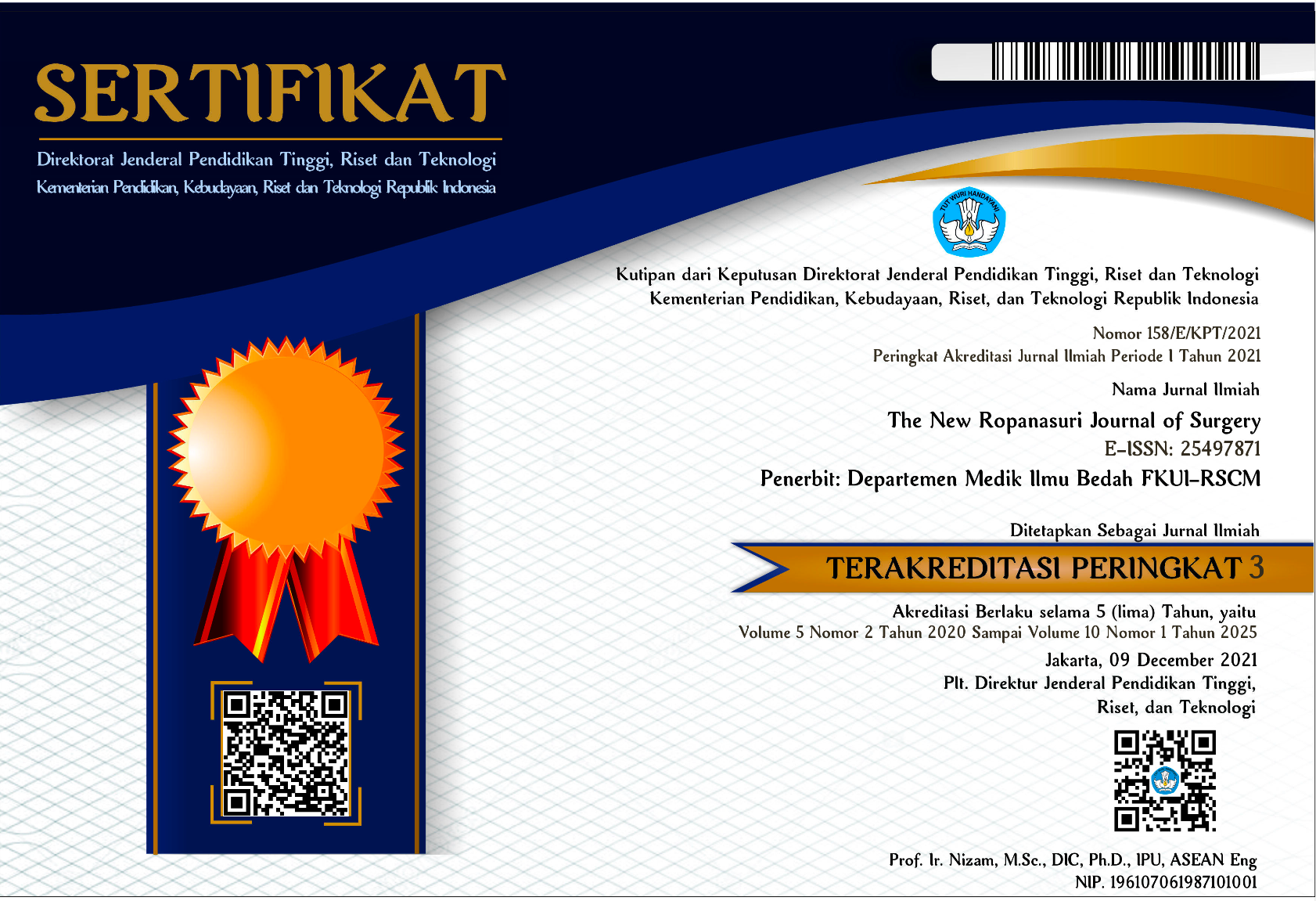Abstract
Background Pancreatic cancer affects 25,000 to 30,000 people in the United States each year and is the fourth or fifth leading cause of cancer-related death in this country. It is generally resected by pancreaticoduodenectomy, with or without preservation of the pylorus and proximal duodenum. Anastomotic leaks, intra-abdominal abscesses, and delayed gastric emptying account for most of the perioperative complications after pancreaticoduodenectomy. Anastomotic leaks of pancreas are resulted pancreatic fistula about 45%. A lot of study that have been done to find risk factors of postoperative pancreatic fistula (POPF) with contradictive results.
Method This study was done for 70 patients of pancreaticoduodenectomy procedure. Data was collected from medical record in 2016-2019. The data are pancreatic texture, pancreatic duct diameter, pancreaticojejunal anastomotic technique, use of stent in pancreaticojejunal, and POPF. We analyzed the data bivariat with Spearman.
Results There are 41,4% male and 58,6% female, Patient with underweight about 21,4%, normoweight 57,1%, overweight 15,7%, dan obese 5,7%. Patient with Diabetes Melitus (DM) about 11,4% and no DM 88,6%. The mean of blood glucose is 136,03 mg/dl. Patient with no POPF about 21,4% and with POPF 78,6%. The A type POPF about 69,1%, B type 14,5%, and C type 16,4%. Pancreatic duct diameter 78,6% and >3 mm about 21,4%. Soft texture pancreas about 22,9% and hard 77,1%. Use of stent about 21,4% and no stent 78,6%. Pancreaticojejunal anastomotic type of dunking or invaginating about 82,9% and duck to mucosa sebanyak 17,1%. The significant risk factor in univariate analysis is diameter of the pancreatic duct (p=0,007).
Conclusion Diameter of the pancreatic duct can be used as a risk factor to predict POPF in pancreaticoduodenectomy procedure.
References
1. Michael L. Malignant Pancreatic Tumor. Sabiston Textbook of Surgery. 18th edition. Saunders. 2007
2. Milena Ilic. Epidemiology of pancreatic cancer. World Journal of Gastroenterology. Baishideng Publishing. Nov 28, 2016.
3. Savio George. Different types of pancreatico-enteric anastomosis. New York. Nov 14, 2017. www.dx.doi.org/10.21037/tgh.2017.11.02.
4. Bing-Yang Hu et al. Risk Factors for postoperative pancreatic fistula : Analysis of 539 successive cases of pancreaticoduodenectomy. World Journal of Gastroenterology. Baishideng Publishing. Sept 14, 2016.
5. F Charles Brunicardi. Pancreas. Schwartz’s Principles of Surgery. Ninth edition. The McGraw-Hill Companies. 2010.
6. Qi-Yu Liu. Analysis of Risk Factors for postoperative pancreatic fistula following pancreaticoduodenectomy. World Journal of Gastroenterology. Dec 14, 2014.
7. Zunxiang Ke. Risk Factors for Postoperative Pancreatic Fistula : Analysis of 170 consecutive cases of pancreaticoduodenectomy based on the updated ISGPS classification and grading system. Wuhan. August, 2018.
8. Yin-Mo Yang. Risk Factors of pancreatic leakage after pancreaticoduodenectomy. Elsevier. China. June 19, 2004.
9. Narongsak Rungsakulkij. Risk Factors for pancreatic fistula following pancreaticoduodenectomy : A Retrospective Study in a Thai tertiary center. World Journal of Gastroenterology. Dec 27, 2017.
10. Jian-Shu Chen. Pancreatic Fistula after pancreaticoduodenectomy : Risk Factors and preventive strategies. Journal of Cancer Research and Therapeutics. China. 2019.
11. Anand C. Patel et al. Evaluation of risk factors for postoperative pancreatic fistula following pancreaticoduodenectomy. Formosan Journal of Surgery. Wolters Klower-Medknow. India. 2019.
12. Guo Xinjung et al. A score model based on pancreatic steatosis and fibrosis and pancreatic duct diameter to predict postoperative pancreatic fistula after pancreatoduodenectomy. BMC Surgery. China. 2019.
13. Robert M. Zollinger. Pancreaticoduodenectomy. Zollinger’s Atlas of Surgical Operation. 9th edition. The McGraw-Hill Companies. 2011.
14. Norman et al. Pancreas. Bailey & Love’s SHORT PRACTICE of SURGERY. 25th edition. Edward Arnold Publishing. 2008.
15. Michal J. Zinner et al. Pancreas. Maingot’s Abdominal Operations. Eleventh edition. The McGraw-Hill Companies. 2007.
16. Jens Werner et al. Resectional techniques: pancreaticoduodenectomy, distal pancreatectomy, segmental pancreatectomy, total pancreatectomy, and transduodenal resection of the papilla of Vater. Blumgart’s Surgery of the Liver, Biliary Tract, and Pancreas. Fifth edition. Elsevier Saunders. USA. 2012.
17. Kumar Kapoor. Pancreas Anatomy. Medscape. Dec 07, 2017. www.emedicine.medscape.com/article/1948885-overview#a1.
18. Dilmurodjon E et al. Systematic review and meta-analysis of postoperative pancreatic fistula rates using the updated 2016 International Study Group Pancreatic Fistula definition in patients undergoing pancreatic resection with soft and hard pancreatic texture. University of Lyon, France. Elsevier Ltd on behalf of IHPBA Inc. April 2018.
19. Margaret et al. Pancreatic Adenocarcinoma. NCCN Guidelines Version 1.2019. www.nccn.org/patients.
20. Bassi C et al. The 2016 update of the International Study Group (ISGPS) definition and grading of postoperative pancreatic fistula : 11 years after. Elsevier Inc. 2017. www.ncbi.nlm.nih.gov.
21. James J Mezhir. Postoperative complications requiring intervention, diagnosis, and management. Blumgart’s Surgery of the Liver, Biliary Tract, and Pancreas. Fifth Edition. Elsevier. 2012.
Recommended Citation
Mazni, Yarman; Syafiuddin, Ardani F.; and Putranto, Agi S.
(2020)
"Intraoperative Pancreatic Assessment in Pancreaticoduodenectomy The Correlation with Pancreatic Fistula Formation,"
The New Ropanasuri Journal of Surgery: Vol. 5:
No.
1, Article 4.
DOI: 10.7454/nrjs.v5i1.1066
Available at:
https://scholarhub.ui.ac.id/nrjs/vol5/iss1/4













